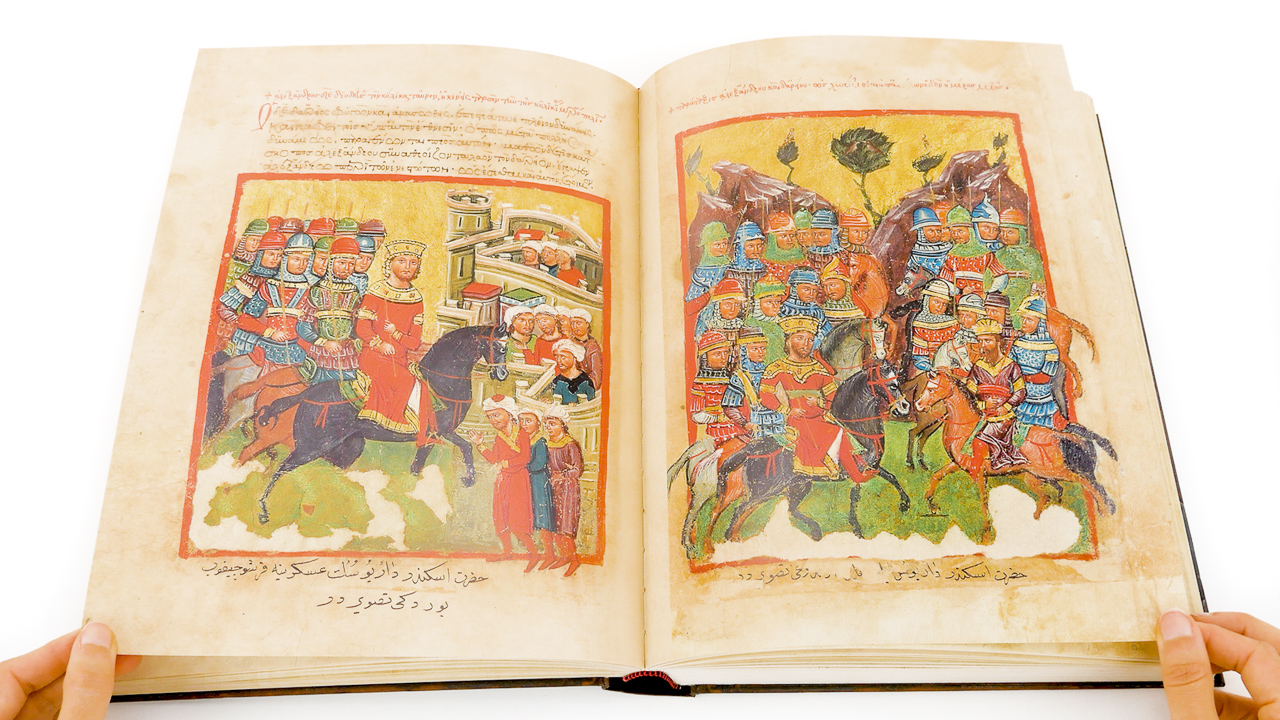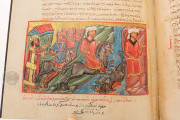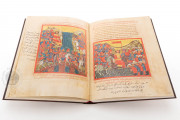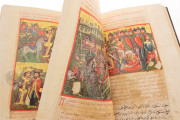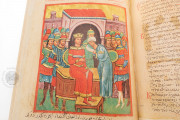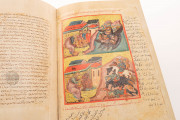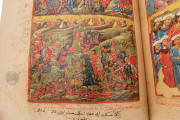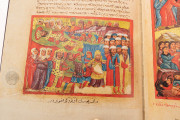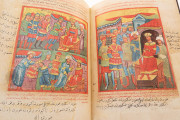The Trebizond Alexander Romance is the only sumptuously illustrated secular romance to survive from Byzantium. As its name suggests, the book originated in the Empire of Trebizond—a Byzantine satellite state on the southeast coast of the Black Sea—and dates to the second half of the fourteenth century. In all probability, it was commissioned by Emperor Alexios III Megas Komnenos (reigned 1349-1390) of Trebizond and features one of the many versions of the so-called Alexander Romance, a pseudohistorical account of the life of Alexander the Great (356-323 BCE, King of Macedon). Much of the appeal of the codex lies in its magnificent decorative apparatus, which features a total of 250 miniatures, often occupying the entire page.
The most richly illustrated surviving manuscript of the Greek romance, the Trebizond Alexander Romance is of exceptional artistic value. The miniatures form a lively visual narrative that provides an almost cinematic approach to the life of the ancient Macedonian king, focusing on his birth, battles, fights with legendary monsters, marriage, visit to the oracle of Zeus Ammon, and death.
A Lavishly Illustrated Version of the Alexander Romance
The luxurious decorative apparatus of the codex has been attributed to three anonymous painters. The miniatures all feature a thick red border and display a profusion of gold in the background and the details of royal garb, while the main color palette features purple, red, and blue.
A remarkable trait of the miniatures is the presentation of Alexander as a Byzantine emperor. A now lost portrait of the ancient king almost certainly once faced the frontispiece, a portrait of Alexios III of Trebizond (fol. 1r). Alexios is represented in a frontal position, facing the viewer while standing elevated on a red cushion. He is clothed in a sumptuous purple robe, his royal position being signaled not only by the crown on his head but also by the elaborate loros (an embroidered belt) that embellishes his garment. With his left hand, extending out towards the viewer, he holds a globe as a clear sign of his authority and power.
A Christianized View of a Greek Military Hero
Traditionally attributed to Callisthenes, a contemporary of Alexander, the original text is probably the product of the third century of the common era. In subsequent centuries, the text was Christianized to present Alexander as having established the worship of the God of the Jews in Alexandria, Egypt. The text of the Trebizond Alexander Romance is the work of a single anonymous scribe, who is known to have been active in 1330 at the court of Trebizond.
The text is written in brown ink, with a darker ink used from fol. 152v onwards. Titles, large initials, and an epigram in Greek (fol. 1r) are all written in red ink. The Greek inscriptions above and below the miniatures are also written in red.
Some inscriptions in Georgian or pseudo-Georgian script appear in the miniatures (e.g., the inscription on the scroll held by a person in the upper miniature on fol. 89v). At some time after the Empire of Trebizond fell to the Ottoman Turks in 1461, captions were added to selected miniatures in Ottoman Turkish using black ink.
Glorious Despite Its Losses
The manuscript's leaves were rearranged at some point in its history, and some leaves have been lost. The ink has sometimes faded, and some miniatures are marred by holes caused by the corrosive properties of the pigments used. As a result, the text on the reverse side of the affected folios presents gaps (e.g., fols. 79-80).
A Tool of Imperial Propaganda?
It has been suggested that Alexios III commissioned this codex as a tool of imperial propaganda meant to establish himself as the legitimate heir to Alexander the Great and Trebizond as a successor to Alexander's empire.
The manuscript was in Venice by the beginning of the nineteenth century probably brought there by Konstantinos Maroutses (Maruzzi). The codex stayed in his house until shortly after his death in 1846. In 1876 it was in the archiepiscopal library of San Giorgio dei Greci, and in 1879 it is attested in the inventory of the portable property of the Greek confraternity of Venice, from which it passed to the newly established Istituto Ellenico in 1953.
We have 1 facsimile edition of the manuscript "Trebizond Alexander Romance": Codex 5 (The Venice Alexander Romance) facsimile edition, published by Istituto Ellenico di Studi Bizantini e Postbizantini, 2022
Request Info / Price
